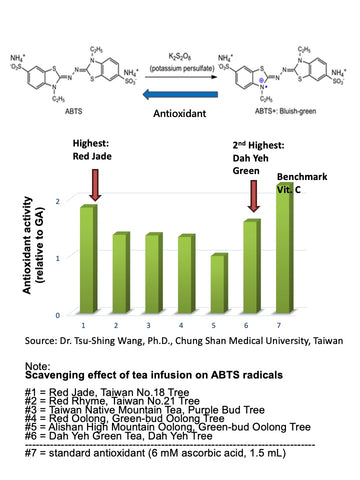It is a popular opinion in the West that green tea is the best source of antioxidants in a drink. However, it is a fact that most Western research did not obtain a solid knowledge of tea per se or test at gold standard. Firstly, most of the research did not control the tea sources, tea trees (instead, only using a very broad variety, Camellia sinensis), levels of oxidisation, the method of brewing temperatures and time, and so on. Secondly, those studies did not compare between different testing days, which might potentially change the levels of oxidisation if tea is not vacuum sealed after opening the package.
I have researched teas and farms for more than 15 years. Many customers of Formosan Farms have asked me questions about whether green tea is the best source in terms of antioxidants in teas, as they were educated by the media or even doctors.
My answer is: NO.
Firstly, it depends upon what tea tree leaves they brew with. For example, the red tea of 100% fermented Red Jade, or Taiwan No.18 tea tree, was tested with the highest level of antioxidant activity among all Formosan Farms teas, including the green tea (Figure 1). The test result in Figure 1 demonstrates the antioxidant activity across different tea trees.

While Green tea is 0% fermented, Oolong tea is partially fermented-- it can vary between 15% to 75% across different types of oolongs, and on the other end, Red tea (or black tea in the West) is 100% fermented. It has to be emphasised that we use the word of "fermentation" rather than "oxidisation" because there are teas, such as GABA teas, which are NOT oxidised but they may be processed into GABA oolong or GABA Red tea with different levels of fermentation.
There are many oxidant compounds that have been proved to benefit health (not exceeding a certain amount). In most medical antioxidant research, they normally investigate:
- Gallic Acid (GA)
- Epigallocatechin (EGC)
- Epigallocatechin Gallate (EGCG)
- Catechins Epicatechin (EC)
- GCG
- Epicatechin Gallate (ECG)
- Caffeine
In the extended research, we control the tea tree by using Dah Yeh Tree only. The following teas tested were from single origin farm in the east coast of Taiwan:
Dah Yeh Green tea-- 0% fermented
Dah Yeh Oolong tea-- 25% fermented
Dah Yeh Red tea-- 100% fermented
We also separated the above three tea samples into two days to re-test them. Figure 2 shows the result of the 7 different antioxidant compounds tested.
The key findings are:
(1) Green tea is more unstable: a significant difference between the two tests
(2) Red tea has higher levels of the antioxidant compounds: GA, GCG, and Caffeine (Dah Yeh Red tea brewed in boiled water here: 56.9mg per cup, benchmarking: a cup, 240ml or 8 o.z., of coffee is on averaged 95mg Caffeine ).
(3) Green tea has higher levels of the antioxidant compounds: EGC, EC, and ECG.
(4) Oolong tea has a balance level across various antioxidant compounds.
Thus, we recommend having a tea as a daily antioxidant source in your diet by choosing the tea you like, you enjoy, and better to suit your current body condition (the higher level the fermentation, the warmer to your body, and vice versa). It is not necessary to insist on green tea, which is cold (as a food attribute, hence better in the summer), and some customers tell us that they did not enjoy matcha green tea used for an antioxidant source.


